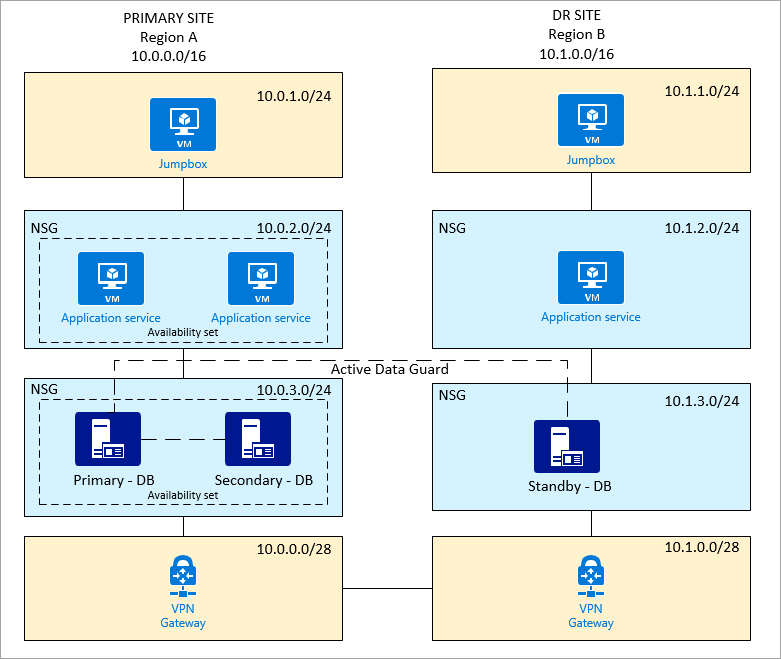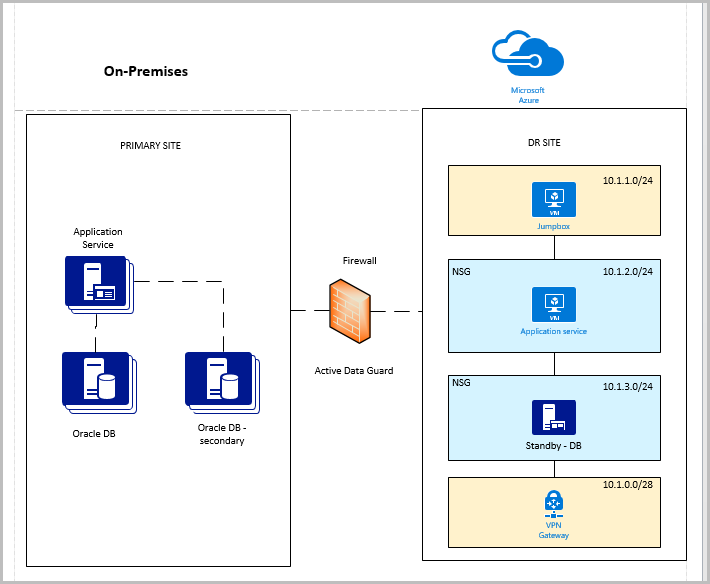Disaster recovery for an Oracle Database 12c database in an Azure environment
Applies to: ✔️ Linux VMs
Assumptions
- You have an understanding of Oracle Data Guard design and Azure environments.
Goals
- Design the topology and configuration that meet your disaster recovery (DR) requirements.
Scenario 1: Primary and DR sites on Azure
A customer has an Oracle database set up on the primary site. A DR site is in a different region. The customer uses Oracle Data Guard for quick recovery between these sites. The primary site also has a secondary database for reporting and other uses.
Topology
The following shows a summary of the Azure setup:
- Two sites (a primary site and a DR site)
- Two virtual networks
- Two Oracle databases with Data Guard (primary and standby)
- Two Oracle databases with Golden Gate or Data Guard (primary site only)
- Two application services, one primary and one on the DR site
- An availability set, which is used for database and application service on the primary site
- One jumpbox on each site, which restricts access to the private network and only allows sign-in by an administrator
- A jumpbox, application service, database, and VPN gateway on separate subnets
- NSG enforced on application and database subnets

Scenario 2: Primary site on-premises and DR site on Azure
A customer has an on-premises Oracle database setup (primary site). A DR site is on Azure. Oracle Data Guard is used for quick recovery between these sites. The primary site also has a secondary database for reporting and other uses.
There are two approaches for this setup.
Approach 1: Direct connections between on-premises and Azure, requiring open TCP ports on the firewall
We don't recommend direct connections because they expose the TCP ports to the outside world.
Topology
Following is a summary of the Azure setup:
- One DR site
- One virtual network
- One Oracle database with Data Guard (active)
- One application service on the DR site
- One jumpbox, which restricts access to the private network and only allows sign-in by an administrator
- A jumpbox, application service, database, and VPN gateway on separate subnets
- NSG enforced on application and database subnets
- An NSG policy/rule to allow inbound TCP port 1521 (or a user-defined port)
- An NSG policy/rule to restrict only the IP address/addresses on-premises (DB or application) to access the virtual network

Approach 2: Site-to-site VPN
Site-to-site VPN is a better approach. For more information about setting up a VPN, see Create a virtual network with a Site-to-Site VPN connection using CLI.
Topology
Following is a summary of the Azure setup:
- One DR site
- One virtual network
- One Oracle database with Data Guard (active)
- One application service on the DR site
- One jumpbox, which restricts access to the private network and only allows sign-in by an administrator
- A jumpbox, application service, database, and VPN gateway are on separate subnets
- NSG enforced on application and database subnets
- Site-to-site VPN connection between on-premises and Azure

Additional reading
- Design and implement an Oracle database on Azure
- Configure Oracle Data Guard
- Configure Oracle Golden Gate
- Oracle backup and recovery